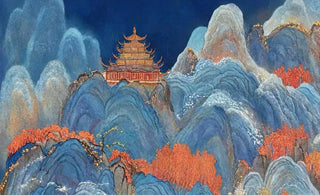
Aesthetic Journey Across Chinese, Japanese, and Indian Arts
Introduction
Welcome to Oriental Aesthetics, your premier destination for experiencing the beauty and elegance of classical oriental art. Our company is dedicated to providing systematic, high-quality professional services for oriental artists, collectors, as well as enthusiasts who appreciate and love the rich heritage of Chinese, Japanese, and Indian arts. In this article, we will take you on an aesthetic journey, exploring the captivating realms of these artistic traditions and shedding light on their unique characteristics.
Chinese Art: A Tapestry of Tradition and Innovation
Chinese art encompasses a vast and diverse array of artistic traditions that have evolved over thousands of years. It is a tapestry woven with threads of tradition and innovation, reflecting the rich cultural heritage and artistic genius of the Chinese people. From the majestic landscapes depicted in classical Chinese paintings to the delicate art of calligraphy, Chinese art captivates with its unique aesthetics and profound symbolism.
Classical Chinese paintings, also known as guóhuà, are a prominent and revered form of artistic expression. These paintings often depict breathtaking landscapes, elegant figures, and scenes from mythology or historical events. The artists' mastery of brushwork and ink allows them to create ethereal and evocative images that capture the essence of the natural world. The use of negative space, the skillful manipulation of light and shade, and the emphasis on harmonious composition contribute to the captivating beauty of Chinese landscape paintings.
Another distinctive aspect of Chinese art is calligraphy, considered one of the highest forms of artistic expression. Calligraphy is not merely the act of writing; it is an art form that combines the aesthetics of brushwork, ink, and the expressive power of individual characters. The strokes of a calligrapher's brush can convey deep emotions, spiritual insights, and philosophical concepts. It is an art that requires years of disciplined practice and a profound understanding of the written language.
In addition to painting and calligraphy, Chinese art is renowned for its mastery of ceramics. Chinese porcelain, with its delicate beauty and exquisite craftsmanship, has captured the imagination of collectors and art enthusiasts around the world. From the iconic blue and white patterns of the Ming dynasty to the intricate famille rose motifs of the Qing dynasty, Chinese porcelain reflects the technical precision and artistic innovation of Chinese potters throughout history. Each piece carries a sense of history and cultural significance, showcasing the intricate designs and vibrant colors that have become synonymous with Chinese ceramics.
Moreover, Chinese art embraces a wide range of other artistic forms, including sculpture, jade carvings, lacquerware, and paper cutting. Each of these art forms has its unique techniques and cultural significance, contributing to the rich tapestry of Chinese artistic heritage.
In conclusion, Chinese art is a testament to the ingenuity, creativity, and cultural depth of the Chinese people. It encompasses a wide range of artistic forms, each with its distinctive characteristics and aesthetic principles. Chinese art celebrates tradition while embracing innovation, creating a harmonious blend of the past and the present. By exploring the captivating realms of Chinese art, one can embark on a journey of discovery, gaining insights into the profound connection between art, culture, and the human experience.
Japanese Art: Serenity in Simplicity
Japanese art, deeply rooted in Zen Buddhism and the appreciation of nature, emanates a sense of serenity and tranquility. Embracing the concept of wabi-sabi, which celebrates imperfection and impermanence, Japanese art forms such as ikebana (flower arrangement), tea ceremony, and bonsai cultivate a profound connection with the natural world.
One of the most recognizable forms of Japanese art is ukiyo-e, the woodblock print tradition that flourished during the Edo period. Ukiyo-e prints depict a wide range of subjects, including landscapes, kabuki actors, and beautiful courtesans. With their vibrant colors, intricate details, and masterful compositions, ukiyo-e prints capture the essence of daily life in old Japan, transporting viewers to a bygone era.
Japanese ceramics, such as the iconic raku ware and delicate porcelain, also hold a special place in the world of art. Raku ware, known for its rustic charm and unpredictable glazes, was developed by the legendary tea master Sen no Rikyu. Its unique aesthetics and the tactile experience it offers have made it a favorite among collectors and tea enthusiasts alike.
Indian Art: A Kaleidoscope of Culture
Indian art is a kaleidoscope of vibrant colors, intricate patterns, and diverse cultural influences. From the intricate sculptures of ancient temples to the awe-inspiring miniature paintings, Indian art reflects the country's rich history, spirituality, and cultural diversity.
One of the most celebrated art forms in India is the art of Bharatanatyam, a classical dance form that originated in the temples of Tamil Nadu. With its graceful movements, expressive gestures, and intricate footwork, Bharatanatyam tells stories from Hindu mythology and evokes a sense of divinity and spirituality.
Indian textiles, such as the luxurious silk sarees and intricately embroidered fabrics, are also renowned for their exquisite craftsmanship and vibrant designs. Each region of India has its unique textile traditions, reflecting the diverse cultural heritage of the country.
Conclusion
At Oriental Aesthetics, we strive to bring the beauty and richness of classical oriental art to the world. Through our systematic, high-quality professional services, we aim to provide a platform for oriental artists, collectors, and enthusiasts to connect and appreciate the timeless beauty of Chinese, Japanese, and Indian arts.
Whether you are a seasoned collector, an aspiring artist, or simply someone who appreciates the elegance of oriental aesthetics, we invite you to embark on a journey of artistic discovery with us. Explore our curated collection, engage with our community, and let the captivating world of oriental art inspire and enrich your life.
























